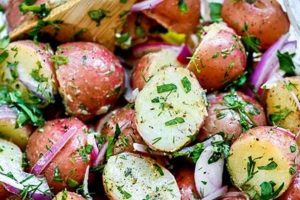A simple preparation of cooked potatoes, combined with a mustard-based dressing, often incorporating other ingredients like mayonnaise, celery, onions, and seasonings. Variations exist using different types of mustard, potatoes, and additional components like hard-boiled eggs or pickles. An example includes small red potatoes boiled until tender, then tossed with a dressing of Dijon mustard, mayonnaise, apple cider vinegar, chopped celery, and red onion.
This dish offers a convenient and flavorful side for picnics, barbecues, and potlucks due to its make-ahead nature and room-temperature serving capability. Its popularity stems from the balance of creamy, tangy, and savory flavors, complemented by the textural contrast between the soft potatoes and crisp additions. Historically, potato salad variations have been present in numerous cultures for centuries, with mustard often appearing as a key flavor component, particularly in European and American cuisine.
Further exploration will delve into specific ingredient selections, preparation techniques, variations, and serving suggestions to create a successful and enjoyable culinary experience.
Tips for Mustard Potato Salad Success
Optimizing ingredient selection and preparation techniques elevates this classic dish. Careful consideration of these tips will ensure a flavorful and satisfying result.
Tip 1: Potato Selection: Opt for waxy potatoes, such as red or new potatoes, which hold their shape well during cooking and prevent a mushy texture. Avoid russet potatoes due to their high starch content.
Tip 2: Cooking Technique: Cook potatoes until tender but firm, avoiding overcooking. Start potatoes in cold, salted water and bring to a boil. Drain immediately upon reaching desired tenderness.
Tip 3: Mustard Choice: Experiment with different mustards to achieve desired flavor profiles. Dijon offers a robust tang, while yellow mustard provides a milder flavor. Stone-ground or whole-grain mustard adds textural complexity.
Tip 4: Dressing Emulsification: Whisk together mustard, vinegar, and seasonings before adding oil or mayonnaise. This creates a stable emulsion, preventing separation and ensuring even flavor distribution.
Tip 5: Flavor Balancing: Achieve a balance of tangy, savory, and sweet flavors. Adjust vinegar, sugar, and seasonings according to personal preferences and the type of mustard used.
Tip 6: Ingredient Incorporation: Add dressing while potatoes are still slightly warm to ensure better absorption. Gently fold in other ingredients, avoiding damage to the potatoes.
Tip 7: Chilling Time: Allow the salad to chill for at least 30 minutes before serving. This allows flavors to meld and enhances the overall experience.
Adherence to these guidelines ensures a potato salad with optimal flavor, texture, and visual appeal. These considerations contribute to a consistently enjoyable culinary experience.
By understanding these fundamental principles, one can confidently create a delicious and satisfying mustard potato salad.
1. Simple Ingredients
The ease of a mustard potato salad recipe often correlates directly with the simplicity of its ingredients. Recipes emphasizing readily available components contribute to both accessibility and reduced preparation time. Potatoes, mustard, vinegar, and common pantry staples like onions and celery form the foundation of many variations. This reliance on basic ingredients eliminates the need for specialized grocery shopping or complex pre-preparation steps, making the dish ideal for impromptu meals or quick side dishes. For instance, a recipe calling for Yukon Gold potatoes, yellow mustard, white vinegar, celery, onion, and mayonnaise can be prepared with items commonly found in most kitchens.
The impact of ingredient simplicity extends beyond convenience. It also contributes to the dish’s adaptability. Using fundamental ingredients as a base allows for customization with herbs, spices, or additional vegetables tailored to individual preferences or dietary needs. This flexibility allows for a wide range of flavor profiles, from classic tangy to subtly sweet or spicy, all while maintaining the recipe’s straightforward nature. Swapping yellow mustard for Dijon, incorporating fresh dill, or adding chopped hard-boiled eggs demonstrates this versatility without sacrificing ease of preparation.
Understanding the role of simple ingredients in an easy mustard potato salad recipe underscores its accessibility and adaptability. This approach simplifies meal preparation while providing a platform for culinary exploration. While challenges can arise in balancing simplicity with flavor complexity, focusing on high-quality core ingredients and thoughtful additions can yield delicious results suitable for various occasions and palates.
2. Quick Preparation
Quick preparation is a defining characteristic of an easy mustard potato salad recipe, crucial for its appeal and practicality. This attribute hinges on efficient techniques and strategic ingredient choices, making the dish suitable for time-constrained cooks and spontaneous gatherings. Minimizing active cooking time without compromising flavor or texture represents a key challenge addressed through streamlined methods and readily available components.
- Pre-cooked Ingredients:
Utilizing pre-cooked ingredients, such as pre-washed and bagged potatoes or pre-chopped vegetables like celery and onions, significantly reduces preparation time. This eliminates steps like peeling and chopping, streamlining the process and allowing for faster assembly. Pre-cooked potatoes can be microwaved or roasted for added convenience, further accelerating the recipe timeline.
- Simplified Dressing:
A simple dressing, often based on readily available condiments like mustard, mayonnaise, and vinegar, minimizes preparation complexity. Whisk-together dressings eliminate the need for elaborate emulsification processes or specialized equipment. Using pre-made sauces or dressings can further reduce time spent on this element. A basic Dijon mustard and apple cider vinegar dressing exemplifies this approach.
- One-Pot/Bowl Approach:
Employing a one-pot or one-bowl method for cooking and mixing streamlines the process and minimizes cleanup. Boiling potatoes and subsequently adding the dressing and other ingredients directly to the same pot reduces dishwashing and simplifies ingredient transfer. This approach optimizes workflow and reinforces the recipe’s easy preparation attribute.
- Make-Ahead Preparation:
Mustard potato salad benefits from make-ahead preparation. The dish can be assembled and chilled several hours or even a day in advance, allowing flavors to meld and saving valuable time on the day of serving. This makes it an ideal option for potlucks, picnics, or planned meals where minimizing day-of preparation is desired.
These facets of quick preparation underscore the convenience and accessibility of an easy mustard potato salad recipe. By strategically leveraging pre-cooked ingredients, simplified dressings, one-pot methods, and make-ahead strategies, the dish becomes a practical and efficient choice for various occasions, demonstrating its value for busy individuals and spontaneous gatherings. The combination of these time-saving elements differentiates an easy recipe from more complex and labor-intensive potato salad variations.
3. Tangy Mustard Flavor
Tangy mustard flavor forms the cornerstone of an easy mustard potato salad recipe, differentiating it from other potato salad variations and contributing significantly to its characteristic taste profile. The interplay between mustard’s inherent pungency and other ingredients establishes a balance crucial for the dish’s overall appeal. Exploring the facets of this tangy element reveals its complexity and impact on recipe development and enjoyment.
- Mustard Variety:
The choice of mustard significantly influences the final flavor profile. Different mustards offer varying levels of tanginess and complexity. Yellow mustard provides a mild tang, suitable for a broadly appealing flavor. Dijon mustard, with its sharper, more pronounced tang, adds depth and complexity. Stone-ground or whole-grain mustard contributes both textural and flavor nuances, introducing a robust tang and subtle bitterness. The selected mustard establishes the foundational flavor base upon which other ingredients build.
- Balancing Acidity:
Balancing the mustard’s tanginess with other acidic elements like vinegar is crucial. Vinegar enhances the tang while contributing a distinct sharpness. Apple cider vinegar offers a mild, fruity acidity, complementing the mustard’s pungency. White vinegar provides a cleaner, more neutral acidity, allowing the mustard flavor to take center stage. The interplay between mustard and vinegar establishes the desired level of tang without overpowering the other flavors.
- Sweetness and Spice:
Incorporating sweetness and spice can further enhance the tangy mustard flavor. A touch of sugar or honey tempers the sharpness, creating a more balanced flavor profile. Adding a pinch of cayenne pepper or a dash of hot sauce introduces a contrasting element, enhancing the perception of tanginess while adding complexity. These elements contribute to a more well-rounded and nuanced flavor experience.
- Flavor Enhancement Through Complementary Ingredients:
Ingredients like celery, onions, and pickles contribute textural contrast and enhance the mustard’s tangy notes. Celery’s crispness and subtle vegetal flavor provide a refreshing counterpoint. Onions offer a pungent bite that complements the mustard. Pickles introduce a tangy, briny element that amplifies the overall tanginess of the salad. These additions create a harmonious flavor profile.
The careful consideration of mustard variety, acidity balance, sweetness, spice, and complementary ingredients contributes significantly to a successful easy mustard potato salad recipe. The interplay of these elements creates a dynamic and flavorful dish where the tangy mustard flavor shines without overwhelming the palate. Understanding these nuances allows for informed recipe customization and ensures a satisfying culinary experience.
4. Versatile Side Dish
Versatility distinguishes mustard potato salad as a side dish, complementing diverse main courses and cuisines. Its adaptability arises from a balanced flavor profiletangy, savory, and subtly sweetharmonizing with grilled meats, fried chicken, fish, and vegetarian options. The salad’s neutral base of potatoes readily absorbs flavors, allowing customization through herbs, spices, and additional vegetables. This adaptability extends to various culinary traditions; the salad complements American barbecue just as effectively as a Mediterranean-inspired meal. For instance, a classic mustard potato salad with celery and onions pairs well with grilled hamburgers, while a version incorporating dill and capers complements roasted salmon.
Practical implications of this versatility extend beyond meal planning. Mustard potato salad’s suitability for picnics, potlucks, and buffets stems from its room-temperature serving capability and make-ahead convenience. The dish travels well and requires minimal on-site preparation, making it a practical choice for gatherings. Furthermore, its adaptability to dietary modifications enhances versatility. Substituting vegan mayonnaise or omitting certain ingredients caters to specific dietary needs without compromising flavor or overall appeal. This adaptability makes mustard potato salad a truly inclusive dish, suitable for a broad range of individuals and occasions. A vegan version using plant-based mayonnaise and omitting eggs retains the dish’s essential characteristics, while a gluten-free variation requires attention to ingredient sourcing, such as ensuring gluten-free mustard and avoiding cross-contamination.
Mustard potato salad’s versatility as a side dish stems from its balanced flavor profile, adaptability to various cuisines, and practical considerations for serving and dietary modifications. This adaptability simplifies meal planning and broadens the dish’s appeal, solidifying its role as a staple side dish across numerous culinary contexts. While challenges exist in balancing flavor profiles for optimal versatility, focusing on quality ingredients and thoughtful customization allows this simple dish to shine in diverse settings.
5. Customizable Recipe
Customizability represents a significant advantage of easy mustard potato salad recipes. This adaptability stems from the recipe’s simple foundation, allowing modifications without compromising the fundamental structure. Ingredient substitutions and additions readily accommodate individual preferences, dietary restrictions, and seasonal ingredient availability. This inherent flexibility allows each preparation to reflect unique tastes and available resources, transforming a basic recipe into a personalized culinary expression. For example, substituting Dijon mustard for yellow mustard alters the flavor profile significantly, while incorporating chopped fresh herbs like dill or parsley adds a fresh, bright dimension. Adding hard-boiled eggs or crumbled bacon introduces protein and textural complexity.
Practical implications of customizability extend beyond individual preferences. Adapting the recipe to available seasonal produce reduces reliance on out-of-season ingredients, promoting both cost-effectiveness and flavor optimization. Substituting vegan mayonnaise or omitting eggs caters to dietary restrictions without sacrificing the dish’s essence. This adaptability also allows cooks to experiment with global flavor profiles. Incorporating curry powder or chopped cilantro transforms the salad into an Indian-inspired side, while using olives and feta cheese creates a Mediterranean variation. This capacity for customization expands the recipe’s utility, making it suitable for diverse culinary applications and cultural contexts.
The connection between customizability and easy mustard potato salad recipes highlights the dish’s adaptability and enduring appeal. While challenges may arise in maintaining balance amidst modifications, the recipe’s foundational simplicity provides a robust framework for experimentation. Understanding this inherent flexibility empowers cooks to personalize the dish, optimizing flavor, accommodating dietary needs, and integrating seasonal ingredients, ultimately enhancing the culinary experience.
Frequently Asked Questions
This section addresses common inquiries regarding easy mustard potato salad recipes, providing concise and informative responses to facilitate successful preparation and enjoyment.
Question 1: What type of potato is best suited for potato salad?
Waxy potatoes, such as red or new potatoes, are recommended due to their ability to hold their shape after cooking. Avoid starchy potatoes like russets, which tend to become mushy.
Question 2: Can the salad be prepared in advance?
Yes, potato salad benefits from chilling, allowing flavors to meld. Prepare the salad up to 24 hours in advance and store it refrigerated in an airtight container.
Question 3: How can the tanginess of the mustard be balanced?
Balance mustard’s tanginess with sweetness and other acidic elements. A touch of sugar or honey, along with a splash of vinegar, can create a more balanced flavor profile.
Question 4: What are suitable substitutions for mayonnaise?
Plain yogurt or Greek yogurt can be substituted for mayonnaise, offering a lighter, tangier alternative. Vegan mayonnaise provides a suitable option for plant-based diets.
Question 5: How can one prevent the potatoes from becoming discolored?
Adding a small amount of vinegar or lemon juice to the cooking water helps prevent discoloration and maintains the potatoes’ vibrant appearance.
Question 6: What are some common additions to enhance flavor and texture?
Chopped celery, onions, hard-boiled eggs, pickles, fresh herbs, and crumbled bacon are popular additions that enhance both flavor and textural complexity.
Addressing these common inquiries clarifies key aspects of easy mustard potato salad preparation, contributing to successful outcomes and enjoyable culinary experiences.
The following section offers variations on the classic recipe, exploring diverse flavor profiles and ingredient combinations.
Easy Mustard Potato Salad Recipe
Exploration of easy mustard potato salad recipes reveals a dish characterized by simplicity, versatility, and adaptability. Key elements include the selection of waxy potatoes, the balance of tangy mustard with other ingredients, and the potential for customization through ingredient additions and substitutions. Quick preparation techniques, make-ahead convenience, and suitability for various occasions contribute to the dish’s widespread appeal. Understanding the interplay of these factors allows for consistent, flavorful results, transforming a basic side dish into a personalized culinary creation.
Culinary exploration of easy mustard potato salad recipes demonstrates the enduring appeal of simple, adaptable dishes. The ability to personalize ingredients and tailor the recipe to individual preferences ensures its continued relevance in diverse culinary landscapes. Further exploration of regional variations and innovative ingredient combinations offers continued potential for culinary discovery and enjoyment.






